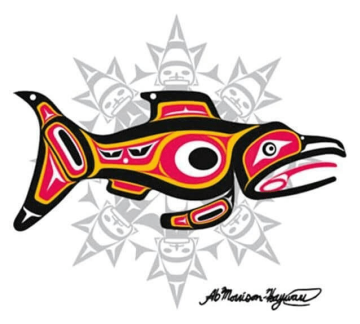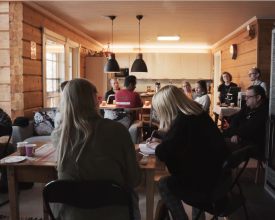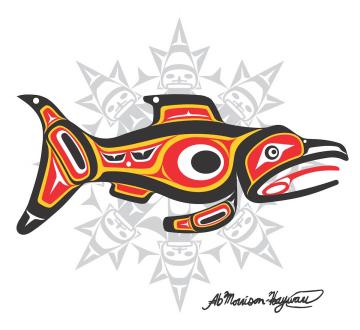
Enhancing a participatory approach to ecological restoration with the River Guardian Program of Koitajoki
Koitajoki Watershed Restoration is a basin-wide river restoration project. The 200-km-long Koitajoki River flows through peatlands and boreal forests in the borderlands between Finland and Russia. The restoration project takes place on the Finnish side of the watershed. Since the 1950s, the river system has suffered from hydropower construction, peatland drainage, forestry, as well as gold and peat mining. The restoration project aims to bring key features of the Koitajoki watershed back to ecological health by restoring drained peatlands and dredged streams and rivers. The project was initiated by the non-profit Snowchange in 2022 and it is on-going at least until 2027.
In 2023, as part of the restoration project, Snowchange established the very first River Guardian Program in Finland. It is a community-based monitoring program with 18 local individuals, families and communities from the Koitajoki Watershed who all share a passion – recovering Koitajoki as seen through the local socio-cultural matrix of lived landscapes.
Context
Challenges addressed
Equity issues have risen in the Koitajoki basin due to top-down extractivism and state-led conservation (national parks, EU Natura 2000 sites). Local communities have mostly been excluded in these processes and left to deal with the environmental legacies. These processes have also generated suspicion and distrust towards conservation. A historic review of power, governance, consent (FPIC) or the role of traditional and local knowledge has not taken place.
The River Guardian Programme of Koitajoki is one method to engage local people in the restoration work on their own terms, and in a manner where their observations, knowledge and concerns are taken seriously.
Location
Process
Summary of the process
In November 2022, an open call for River Guardians was shared online and in the local newspaper. Followed by applications, the very first River Guardian Meeting was held in January 2023, kicking off the program with 14 river guardians. A second call was opened in November which brought four more guardians to the program in early 2024, totaling in 18 guardians from all walks of life, gender and age groups. These guardians monitor changes in their local environment, collect environmental observations and archival materials, conduct interviews with Elders as well as participate in the practical restoration work (BB2). The starting point is the interest and motivation of each guardian (BB1). The guardians also exchange with researchers and play a valuable role in the scientific efforts of the restoration project (BB5). Long-term commitment (BB3) as well as good communication (BB4) have resulted crucial for the success of the program. The river guardians receive a monthly compensation for their work.
Building Blocks
bottom-up approach
The River Guardian Program is based on the interests and motivations of the guardians themselves. The guardians choose the ways and methods they wish to participate in the program. They also choose whether they prefer to work solo, with family members or as a larger group of villagers.
This is a different approach from more conventional citizen science or volunteer monitoring where scientists set the methods, protocols, and objectives of the monitoring efforts which are then followed by volunteers. A bottom-up community-based approach ensures that community-defined issues are addressed and allows a reciprocal dialogue between community members and the restoration project. River guardians are involved in planning their monitoring work as well as in interpreting the results.
Free, Prior, and Informed Consent (FPIC) is applied throughout the process, including when river guardians work with other community members, for example when conducting interviews.
Diverse ways to participate
There is no “one size fits all” for being a river guardian. Some guardians especially enjoy joining the practical restoration actions, such as blocking the ditches of a drained peatland, or creating spawning sites for migrating fish, while others prefer to solely focus on their monitoring efforts. Offering several ways to participate helps keep many people with different interests and strengths involved. The guardians can also present suggestions of what they would like to have organized as part of the program, such as workshops.
Long term commitment
Snowchange has worked in the Koitajoki Catchment since 2017. The Koitajoki Restoration Project started in 2022 and the River Guardian Program kicked off in 2023. In early 2025, one of the river guardians mentioned that only after three years, people in the area have gotten aware of the restoration project and started seeing it as a truly good thing. Gaining acceptance is a slow process. In addition, long-term continuity in a river guardian’s own observations builds motivation as one can see the multitude of their own observations and already draw some conclusions based on them.
Open communication
By taking active part in various village events and meetings, Snowchange has tried to openly communicate about the restoration plans and to be open about the funding and its spending locally. River guardians have found that it is crucial that an organization shares what they have concretely done in the area and gives possibilities for people to get involved.
River Guardian Meetings are held twice a year, in addition to informal meetings with individual guardians. Issues are also communicated via a mailing list as well as in a WhatsApp group.
River guardians can also be found to act as “mediators” in their communities. When information of the restoration project is transferred to villages through them, it is more likely trusted, and people might be more eager to join events.
The River Guardian Program has also enabled the communities themselves to communicate their knowledge through different methods, such as a community theatre play.
Collaboration of local knowledge and science
River guardians exchange with Snowchange researchers about their findings. The knowledge and observations of river guardians play a valuable role in the scientific efforts of monitoring restoration outcomes as well as the planning of restoration sites. Examples of such collaboration include the detection of endangered species, their populations and movements, water quality and flow measurements as well as drone footage of restoration sites. Interviews with Elders can reveal little-known pasts which can be used as ecological baseline information regarding restoration. Those river guardians who are willing to develop their monitoring efforts towards a certain direction, are supported by researchers to find new ideas and practices.
In 2025, one of the river guardians initiated and leads a study focusing on the experiences, thoughts, feelings and ideas of the guardians themselves with regards their role as river guardians.
Impacts
- The River Guardian Program helps reshape the narrative of conservation and restoration, recognising the significance of integrating diverse, local perspectives for effective environmental stewardship.
- It helps increase local acceptance of restoration as well as to reduce distrust created by the legacy problems.
- It helps increase community resilience.
- Local people who continue to possess deeper readings of their place, contribute to gaining a more holistic and multidimensional understanding of the area and reveal many times hidden and little-known aspects. This also supports the scientific monitoring and planning of restoration.
- The River Guardian Program has brought people together. New relationships have formed and existing ones have gotten closer.
Beneficiaries
Local community of Ilomantsi

